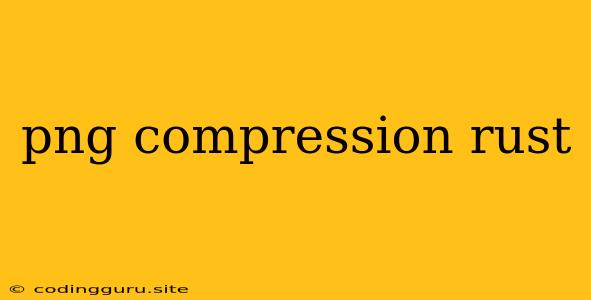PNG Compression in Rust: A Comprehensive Guide
Are you working on a project in Rust that involves handling PNG images and need to compress them efficiently? Look no further! Rust, with its focus on performance and control, provides powerful tools for compressing PNG images, making it ideal for various applications.
Why Compress PNG Images?
PNG (Portable Network Graphics) is a widely used image format known for its lossless compression, providing high-quality images without sacrificing detail. However, PNG files can be quite large, impacting download times and storage space. Compressing PNG images becomes crucial in scenarios where:
- You're dealing with large image datasets: Optimizing image sizes can significantly reduce storage requirements and improve processing speed.
- You're building web applications: Smaller image sizes mean faster loading times, enhancing user experience and improving website performance.
- You're working on resource-constrained devices: Compressing images can help you fit more data within limited memory and storage.
How Does PNG Compression Work?
PNG compression utilizes a combination of techniques:
- Deflation: This is a lossless data compression algorithm that uses a combination of Huffman coding and LZ77 to achieve high compression ratios.
- Filtering: This technique removes redundancy within image data by predicting pixel values based on their neighbors. The most commonly used filter is the Paeth filter, which effectively reduces image size.
Compressing PNG Images with Rust
Rust offers several excellent libraries for working with PNG images and implementing compression techniques:
- image: A versatile image processing library that provides functionalities for reading, writing, and manipulating images in various formats, including PNG.
- png: A dedicated PNG library focused on providing a low-level interface for working with PNG files, including encoding and decoding data.
- lodepng: A C-based PNG library that can be integrated into Rust projects through foreign function interface (FFI).
Example using image library
Let's explore a simple example using the image library:
use image::{DynamicImage, ImageEncoder, ImageFormat, RgbaImage, GenericImageView};
fn compress_png(input_path: &str, output_path: &str, quality: u32) -> Result<(), Box> {
// Read the PNG image
let image = DynamicImage::open(input_path)?.to_rgba8();
// Compress the image with specified quality
let encoder = ImageEncoder::new_with_format(ImageFormat::Png);
let mut buffer = Vec::new();
encoder.encode(&image, &mut buffer, quality)?;
// Write the compressed image to a new file
std::fs::write(output_path, buffer)?;
Ok(())
}
fn main() -> Result<(), Box> {
compress_png("input.png", "compressed.png", 75)?;
println!("PNG image compressed successfully.");
Ok(())
}
This code snippet demonstrates how to use the image library to:
- Read an input PNG image.
- Convert it to an RGBA format.
- Compress the image using a chosen quality level (0 to 100, with lower values resulting in higher compression).
- Write the compressed image to a new file.
Advanced PNG Compression
Beyond basic compression, you can further optimize PNG images for specific use cases:
- Color depth optimization: If your image doesn't require full 24-bit color depth, converting it to 8-bit or even indexed color can significantly reduce file size.
- Interlacing: This technique allows for progressive image display, where a low-resolution version appears first, followed by higher resolution details. While it may not reduce file size, it can improve user perception.
- Adaptive filtering: Implement custom filtering techniques based on image characteristics to further reduce redundancy and achieve optimal compression ratios.
Choosing the Right Compression Method
The ideal PNG compression method depends on your project's specific requirements:
- For general use cases: The
imagelibrary provides a simple and convenient way to compress PNG images with quality control. - For low-level control: The
pnglibrary offers fine-grained control over encoding and decoding parameters, allowing you to customize the compression process. - For complex scenarios: Explore libraries like
lodepngor consider developing custom filtering algorithms if you need more advanced compression strategies.
Performance Considerations
Rust's focus on performance makes it a suitable choice for image processing. However, optimizing compression efficiency can be crucial for large images. Consider the following tips:
- Utilize multithreading: Leverage Rust's multithreading capabilities to distribute the compression workload across multiple cores, reducing processing time.
- Implement memory optimization: Minimize memory usage during image processing by efficiently managing data structures and avoiding unnecessary copying.
- Profile and benchmark: Use profiling tools to identify bottlenecks in your compression code and optimize specific areas for improved performance.
Conclusion
Compressing PNG images effectively in Rust is essential for managing large image datasets, enhancing web application performance, and optimizing resource usage. By leveraging libraries like image, png, and lodepng, you can easily implement various compression techniques and fine-tune the process for optimal results. Remember to consider performance aspects and choose the right method based on your project's specific requirements.
